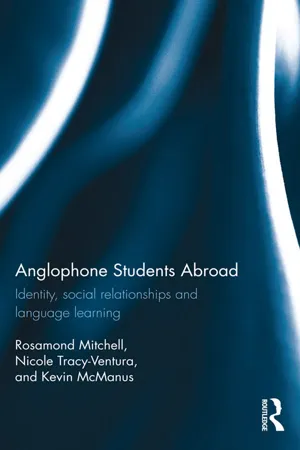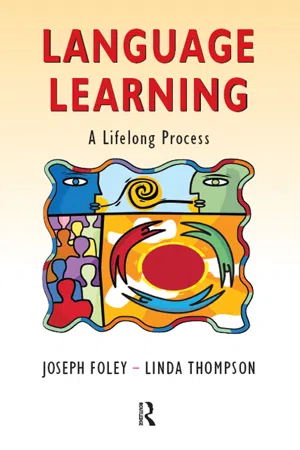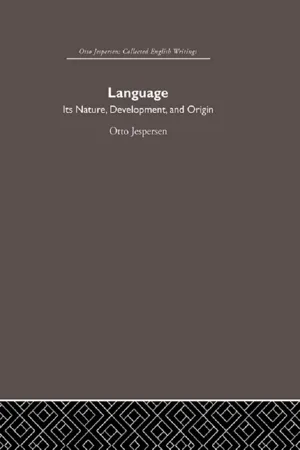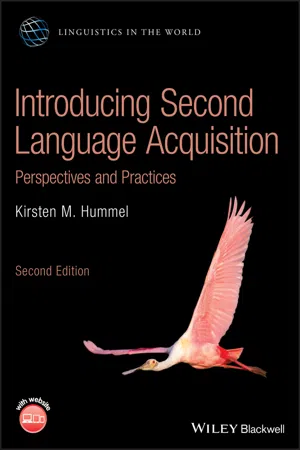Historical Development
Historical development in linguistics refers to the evolution and changes in languages over time. It encompasses the study of how languages have developed, diversified, and influenced each other through various historical, social, and cultural factors. Understanding historical development is crucial for tracing the origins of languages, identifying language families, and analyzing language change and variation.
5 Key excerpts on "Historical Development"
- eBook - ePub
- Kristin Denham, Anne Lobeck(Authors)
- 2018(Publication Date)
- Routledge(Publisher)
...7 Studying language change Historical linguistics We briefly explored in Chapter 2 how language changes over time, which is easy to see when we compare Old English, Middle English, and Present Day English. We also introduced the idea that language change is happening right now, as word meanings, pronunciations, and even our syntax changes (slowly but surely). Think about how your own speech may be different from your parents’ or grandparents’ (I know my own grandmother would never have said yeah right, nor would she have blogged or even owned a computer.) We take up the study of language variation, or language change in progress, in more detail in the following chapter; here, we will provide a little more in-depth discussion of historical or diachronic linguistics, the study of language change over time. The study of language in the eighteenth century The study of historical linguistics as we know it today became particularly prominent after 1786, when Sir William Jones gave a lecture at the Royal Asiatic Society, suggesting that the Germanic languages and the Romance languages descended from a common ancestor (or, more specifically, that Sanskrit, Greek, and Latin had a common parent language, and that other Celtic and Indic languages might share that ancestor as well). Prior to this period, these individual languages were certainly well studied, but the focus was on individual languages, not on how they might be related to each other. Work on these relationships among languages, or language families, became prominent during the nineteenth century, and marked a shift in the methods that scholars used to study language. Researchers took a more scientific approach, comparing sets of data from different languages and formulating and testing hypotheses based on those data. Specifically, during this time scholars developed the comparative method, which we discuss in more detail below...
- eBook - ePub
Anglophone Students Abroad
Identity, Social Relationships, and Language Learning
- Rosamond Mitchell, Nicole Tracy-Ventura, Kevin McManus(Authors)
- 2017(Publication Date)
- Routledge(Publisher)
...5 Linguistic development in Spanish 5.1 Introduction This chapter is a companion to Chapter 4 on the development of L2 French. The chapter therefore is focused on the 27 LANGSNAP participants majoring in L2 Spanish, who spent their period of residence abroad in Spain or Mexico. Linguistic development is conceptualized in the same way, in terms of general proficiency, fluency, accuracy, syntactic complexity and lexical diversity. The chapter begins by briefly summarizing what is known from Spanish L2 study abroad (SA) research, and then describes in detail the participants’ longitudinal linguistic development in Spanish. Evidence is provided regarding group profiles and rate of development over time, and also the extent of individual variation. The chapter concludes with a comparison between profiles of development in the two languages, highlighting their general similarity and considering reasons for this, but also discussing specific linguistic differences. 5.2 Background Much of the research on Anglophone language learning during SA has focused on L2 Spanish with results pointing to clear advantages in the areas of fluency, lexis, and sociolinguistic awareness, but less so in grammar (Lafford & Uscinski, 2014). Most researchers have investigated the experience of university sojourners, typically measuring gains made after a semester abroad, although research focusing on gains made during short-term study abroad has become more popular in recent times. Studies investigating an academic year abroad (or longer) are much less common. In this section we review research on Spanish SLA, focusing on Spanish learning when SA is involved. We mainly concern ourselves with studies of one semester or longer, and those which investigated the constructs under investigation in LANGSNAP (i.e., general proficiency, fluency, accuracy, syntactic complexity, and lexis)...
- eBook - ePub
Language Learning
A Lifelong Process
- Joseph Foley, Linda Thompson(Authors)
- 2017(Publication Date)
- Routledge(Publisher)
...This led to the emergence of a new variety of English, now established as Estuary English. These studies all support the view that a number of factors influence and precipitate change in a person’s linguistic repertoire. Changing geographic location is perhaps the more obvious but coming into contact with people who speak different language, or the same language differently, can also influence. 11.2 Contexts and the creation of a linguistic biography The dimension of context as central to learning and using language(s) gets support from systemic linguists. Their description of language as a socio-semiotic system of signs makes context a central concern. It is important to emphasize that this should not be understood as regarding language and context as separate. Halliday (1978a) describes language as the dynamic process that actually creates social situations. Hence it is inevitable that the different life experiences, the people we meet, the places we visit and live in, will all contribute to our personal linguistic biography making it distinct from others. In addition, the different social contexts that we participate in and which we help to create will also contribute to our personal, social and linguistic biography. A person’s life comprises a range of very different experiences. However, the social psychologist Jerome Bruner suggests that these varied and different spheres of personal experience are not separate or compartmentalized for people. He suggests that they combine in a variety of ways. For example, let us consider the family as a social unit to illustrate this point. Families invent practices for themselves and their members. These practices exist on a number of levels and can include daily routines like how meal times are observed and conducted, as well as less frequent events like annual cultural events as well as religious and other celebrations...
- eBook - ePub
Language
Its Nature and Development
- Otto Jespersen(Author)
- 2013(Publication Date)
- Routledge(Publisher)
...What is wanted is not a comparison of isolated facts, but the establishment of general laws and tendencies, for only through such can we hope to decide whether or no we are justified in using terms like 'development' and 'evolution' in linguistic history.The second reason why the earlier pronouncements quoted above do not satisfy us is that their authors nowhere raise the question of the method by which linguistic value is to be measured,by what standard and what tests the comparative merits of languages or of forms are to be ascertained. Those linguists who looked upon language as a product of nature were by that very fact precluded from establishing a rational basis for determining linguistic values; nor is it possible to find one if we look at things from the one-sided point of view of the linguistic historian. An almost comical instance of this is found when Curtius (Sprachwiss. u. class. phil.39) says that the Greek accusativepódais better than Sanskritpadam,because it is possible at once to see that it belongs to the third declension...
- eBook - ePub
Introducing Second Language Acquisition
Perspectives and Practices
- Kirsten M. Hummel(Author)
- 2020(Publication Date)
- Wiley-Blackwell(Publisher)
...7 Second Language Development Only by treating language learners' language as a phenomenon to be studied in its own right can we hope to develop an understanding of the processes of second language acquisition Source: Corder, S. P. (1978, p. 71) Chapter outline 7.1 Chapter overview 7.2 Common processes and influences 7.2.1 Cross‐linguistic influence (transfer) 7.2.2 Overgeneralization 7.2.3 Markedness 7.2.4 Developmental sequences 7.2.5 Formulaic sequences 7.2.6 Fossilization 7.2.7 Avoidance 7.3 L2 development across linguistic subfields 7.3.1 Phonology 7.3.2 Vocabulary 7.3.3 Grammatical development 7.3.3.1 Morphology 7.3.3.2 Syntax 7.3.3.3 English L2 question development 7.3.4 Sociolinguistic variation and pragmatics 7.3.5 The development of literacy‐based skills 7.3.5.1 Reading 7.3.5.2 Writing 7.4 Investigating learner language: Language corpora 7.5 Summing up Key concepts Self‐assessment questions Discussion questions Exercises / Project ideas References Further reading and viewing Learning objectives Gain a basic understanding of: Processes that affect second language acquisition (SLA) Second language development across subareas: phonology, vocabulary, grammar, pragmatics, reading, writing 7.1 chapter overview As discussed in Chapter 6, there have been a number of different approaches to teaching a second language. Each approach has tended to emphasize certain characteristics of the L2 learning process. This chapter will describe some of the common processes and influences found in L2 development. We will also examine the various linguistic subsystems, such as phonology, vocabulary, grammar, and pragmatics, as well as literacy‐related processes, i.e. reading and writing, in order to get an overview of how these develop in a second language. 7.2 common processes and influences A number of similar processes and influences appear to characterize second language development...




